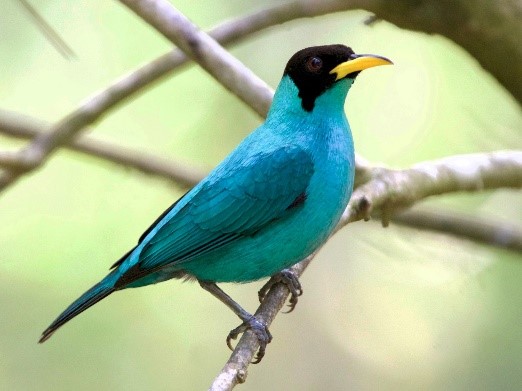Description

Disclaimer: Copyright infringement not intended.
Context
- Ornithologists in Colombia have photographed a wild green honeycreeper (Chlorophanes spiza) with distinct half green, or female, and half blue, male, plumage.
Green Honeycreeper
- The Green Honeycreeper (Chlorophanes spiza) is a small, brightly colored bird belonging to the tanager family (Thraupidae). Here are some key aspects about the Green Honeycreeper:
Physical Characteristics:
- Male: Adult males are strikingly vibrant with their bright green plumage. They have a black mask around their eyes and a brilliant turquoise-blue patch on their throat and chest.
- Female: Females, on the other hand, are less colorful, mainly being olive-green with a bluish tinge on the head and back.

Distribution:
- Green Honeycreepers are native to Central and South America, inhabiting tropical and subtropical forests.
- Their range includes parts of Mexico, Central America, and South America, from Colombia and Venezuela to Brazil and Bolivia.
Habitat:
- These birds are commonly found in the canopy of tropical rainforests, as well as in forest edges and secondary growth areas.
Diet:
- The Green Honeycreeper's diet primarily consists of nectar, fruits, and insects.
- They play a crucial role in pollination as they feed on nectar from flowers.
Behavior:
- Green Honeycreepers are known for their agile and acrobatic movements as they navigate through the vegetation in search of food.
- They often move in small groups or family units.

Reproduction:
- Breeding habits can vary across their range, but generally, they build cup-shaped nests in trees, using plant fibers, leaves, and other materials.
- The female typically lays a small clutch of eggs, and both parents are involved in incubation and caring for the chicks.
Conservation Status:
- The IUCN (International Union for Conservation of Nature) status for the Green Honeycreeper (Chlorophanes spiza) is categorized as "Least Concern."
- This classification indicates that, at that time, the species was not facing imminent threats that would lead to a decline in its population significant enough to warrant a higher conservation status.
|
PRACTICE QUESTION
Question:
Which of the following statements about the Green Honeycreeper (Chlorophanes spiza) is/are correct?
1. It belongs to the family Thraupidae and the order Passeriformes.
2. Adult males display a vibrant green plumage with a turquoise-blue patch on the throat and chest.
3. The Green Honeycreeper primarily feeds on seeds and small insects.
4. The species is classified as "Least Concern" on the IUCN Red List.
Select the correct answer using the codes below:
A) 1 and 2 only
B) 2 and 3 only
C) 1, 2, and 4 only
D) 2 and 4 only
Answer:
B) 2 and 3 only
|














